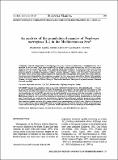Please use this identifier to cite or link to this item:
http://hdl.handle.net/10261/23394Share/Export:
 SHARE SHARE
 CORE
BASE CORE
BASE
|
|
| Visualizar otros formatos: MARC | Dublin Core | RDF | ORE | MODS | METS | DIDL | DATACITE | |

| Title: | An analysis of the population dynamics of Nephrops norvegicus (L.) in the Mediterranean Sea |
Other Titles: | Análisis de la dinámica de las poblaciones de Nephrops norvegicus (L.) en el Mediterráneo | Authors: | Sardà, Francisco CSIC ORCID; Lleonart, Jordi CSIC; Cartes, Joan Enric CSIC ORCID | Keywords: | Population dynamics LCA Y/R Mediterranean Nephrops norvegicus Fishery Dinámica de poblaciones Mediterráneo Pesquería |
Issue Date: | 30-Dec-1998 | Publisher: | Consejo Superior de Investigaciones Científicas (España) | Citation: | Scientia Marina 62(S1): 135-143 (1998) | Abstract: | [EN] The state of exploitation of the Nephrops norvegicus fisheries in different areas in the Mediterranean Sea is examined for the first time. Length cohort analysis (LCA) by sex has been applied for each area, and Y/R curves are presented to show the current status of the stocks under the steady-state assumption. A simulation of short and long-term
effects of changes in fishing effort levels is presented. Norway lobster populations in the Mediterranean share the same biological features, but different exploitation patterns have been observed in several areas. Considering current exploitation levels, certain of the stocks analysed appear to be slightly growth-overexploited, while others seem to be placed near the optimum level of exploitation. For comparison purposes, the study areas can be classified as follows: fully exploited: Catalan Sea (Spain), Adriatic Sea and Tyrrhenian Sea (Italy); moderately exploited: Ligurian Sea (Italy) and Euboikos Gulf (Greece); and lightly exploited: Atlantic (Portugal). The stock in the Alboran Sea (Spain) is a special case and is therefore discussed separately [ES] Se analiza, por primera vez en el Mediterráneo, el estado de explotación de la pesquería de cigala (Nephrops norvegicus) en siete áreas distintas. Para ello se ha aplicado un LCA (análisis de cohortes por tallas) para cada sexo y área Se presentan las curvas de producción por recluta (Y/R) para comparar el estado actual de las poblaciones estudiadas asumiendo su estado de equilibrio. También se realiza un estudio simulado de los efectos del cambio de esfuerzo a largo plazo. La cigala en el Mediterráneo presenta unas características biológicas similares pero con diferentes estados de explotación en las diversas áreas. Considerando los actuales estados de explotación, algunos de las poblaciones estudiadas presentan cierta sobreexplotación de crecimiento, mientras que otras se sitúan alrededor del nivel óptimo de explotación. A modo comparativo, las áreas estudiadas pueden situarse en el siguiente gradiente: plenamente explotadas: el mar Catalán (España), el Adriático y el mar Tirreno (Italia); medianamente explotados: el mar Ligur (Italia) y el golfo de Euboikos (Grecia); y poco explotada, la costa de Atlántica (Algarve, Portugal). La población del Mar de Alborán es un caso especial y se discute separadamente |
Description: | 9 pages, 3 figures, 7 tables | Publisher version (URL): | https://doi.org/10.3989/scimar.1998.62s1135 | URI: | http://hdl.handle.net/10261/23394 | DOI: | 10.3989/scimar.1998.62s1135 | ISSN: | 0214-8358 | E-ISSN: | 1886-8134 |
| Appears in Collections: | (ICM) Artículos |
Files in This Item:
| File | Description | Size | Format | |
|---|---|---|---|---|
| Sarda_et_al_1998.pdf | 243,19 kB | Adobe PDF |  View/Open |
CORE Recommender
Page view(s)
469
checked on Apr 19, 2024
Download(s)
208
checked on Apr 19, 2024
Google ScholarTM
Check
Altmetric
Altmetric
WARNING: Items in Digital.CSIC are protected by copyright, with all rights reserved, unless otherwise indicated.
